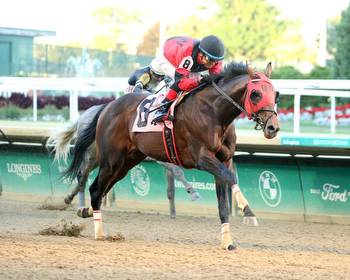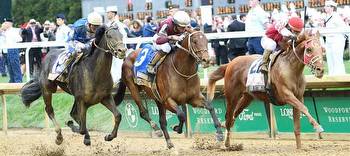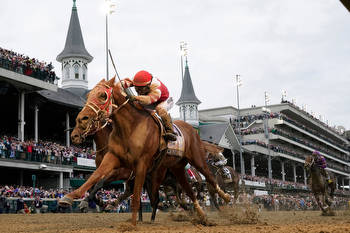Flatter: Are big fields for Ky. Derby preps a surprise?

Pick a topic. Any topic. Because I could not.
Numbers of encouragement. Saturday’s four Kentucky Derby 2023 preps have a total of 46 horses in the main draws with threealso-eligibles. Between 2020 and 2022, the same races had combined fields of36, 40 and 40. Hall of Fame trainer Todd Pletcher, who has Eclipse Award winnerForte in the Fountain of Youth (G2) and front-running long shot Recruiter inthe Gotham (G3), said, “I’m not surprised that it’s large fields in a lot ofthem.” But the 10 entrants in the San Felipe (G2) caught him off guard. “TheCalifornia race did surprise me a little bit,” he said on my podcast this week. “We haven’t seen toomany field sizes like that there in 3-year-old preps. It’s definitely the timeof year where it’s time to fish or cut bait.” Between the rising urgency of theDerby trail and the fat purses in Kentucky that have helped Turfway Park allwinter, the betting public will be the beneficiary. At least the betting publicwho can crack the code on who will win these races.
Chalk burn or no chalk burn. Long shots Angel ofEmpire at 13-1 and Confidence Game at 18-1 won the first two win-and-you’re-inDerby preps. So far in the 2022-23 points races in the U.S., Europe and Japan,favorites have won only 31.0 percent of the time. If that trend holds, it wouldbe the second worst season for chalk since the Derby points system got started10 years ago. The worst was 2013-14, when only 29.4 percent of the post-timefavorites won in the buildup to California Chrome’s victory in Kentucky. Favoriteswon more than half the preps in 2014-15 and 2017-18. American Pharoah andJustify punctuated those years with Triple Crowns.
From the Bayou to the desert. The most prominentopponent and proponent of the Horseracing Integrity and Safety Act have theirmost high-profile events of the year next week. The National Horsemen’s Benevolentand Protective Association holds its annual conference in New Orleans, and thenthe National Thoroughbred Racing Association hosts the National HorseplayersChampionship in Las Vegas. HISA might not get much of an airing among thecontest gamblers in Nevada, but it sure will get the once-over early in the weekfrom the NHBPA. Personally, I will be most curious about the Tuesday paneloutlining alternatives to HISA. While I agree with the horsemen’s group that theHISA rollout has been clumsy at best and inexcusably opaque at worst, I also thinkthe NHBPA should feel compelled to come up with a better idea to fix what ailsour game.
The answer to all your questions … There was athoughtful Tweet posted Thursday morning. That alone would be news. To the point,it was written by Craig Bernick, presumably the breeder-owner from Florida.Presumably, because there was no blue check mark, as if that means anythinganymore on Twitter. “Not perfect,” the post said, “but to me, the best way tofix racing regulation (is) a backside dispensary with full vet disclosure andfreezing of post-race samples. Feed, hay and medication all sourced throughapproved suppliers. Anything but allowed substances in a post-race sample is apositive.” That all sounds fine and good and maybe even overdue. One question.Who is going to pay for it?
… is money. Between the legal fights that have keptattorneys on the clock and the inability to collect fees from state regulators becauseof the delay in starting its medication-program, HISA has run into moneytrouble. So say two insiders who would know. Not that it is in danger offinancial collapse, but if its current business model survives, it stands toreason the proverbial hat will have to be passed to collect more money fromracing commissions around the country. Then it is a matter of who really willabsorb the added cost. If it comes down to owners, breeders and horseplayers,why do I fear it will be the latter? After all, HISA is a government program.
Quantifying the last click. There was another inspiredTweet this week. It came from Marshall Gramm, the economics professor fromTennessee who owns and plays horses and often generates some eyebrow-raisingdata. He put together a chart showing how much the win odds moved in that lastclick at the start of races in the U.S. and Canada in the last 16 months. Thetracks that had the smallest changes? Saratoga, Belmont Park and Aqueduct. Andit was not even close. One big factor had to be the New York Racing Association’smove in the summer of 2021 to cut off computer players three minutes beforepost time. What NYRA lost in business, it gained in credibility on thetoteboard. Gulfstream Park, Del Mar, Churchill Downs, Woodbine and Golden GateFields were clustered fourth through eighth, but they were open lengths behindthe New York Racing Association. The bottom five tracks were Will Rogers Downs,Prairie Meadows, Mountaineer, Arizona Downs and, 53rd and last, Arapahoe Park,all with relatively small handles. While it is true that big tracks attractingbig pools are more likely to be immune from last swings in the odds, Gramm’sresearch was important food for thought for everyone from racetrack managers to$2 bettors.
Unintended consequences. Churchill Downs’ arbitrary Tuesdaydeadline this week forced owners to move their 3-year-olds out of Bob Baffert’sbarn if they wanted to be eligible for the Kentucky Derby. Those moves may createan anomaly in futures betting. As oddsmaker Paul Bach of Caesars Sportsbook said1 1/2 years ago, “I tend to have Baffert horses lower, because they always getplayed off the board regardless of odds.” Now that Cave Rock and Faustin alreadyare out of the mix, what will become of the money that might have been bet onthem in the next few weeks? It could go to other horses, but chances are itwill just disappear. The most significant culling of the futures herd usuallydoes not start for another two or three weeks. If it happens sooner, value willbe harder to find, especially for players looking to bet large chunks ofbankroll, grab big odds now for a few Derby starters and then hedge against themon race day. With Tuesday’s deadline and the thinning of the Baffert, orBafteen, candidates, that ship might have sailed.


































